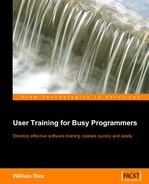Book Description
Develop effective software training classes quickly and easily
A complete guide to creating software training courses and materials
Concise and practical step-by-step approach
Check-lists ensure that you are fully prepared
Based on proven educational techniques
In Detail
If you need to write a successful software training course and are unsure of how to start, then this book gets right to the point with clear, concise directions for developing an end-user software course. This step-by-step job aid walks you through the process of developing a successful, instructor-led software class.
There are many good books on training theory. This book takes a more practical, condensed approach for when you don't have time to learn training theory. It is based on fifteen years of technical writing and training experience. In under 100 pages, the book guides you through the process of developing an end-user software course using a method that is tested, proven, and based upon sound instructional theory.
William Rice has spent over 20 years developing software training, user documentation, and knowledge management solutions with some of the biggest companies in the United States. During that time, he has built up a unique understanding of the training industry that lead him to writing this book.
"Even though software training has come into its own as a profession, I still see many situations where programmers and customer service reps are called upon to develop and deliver training. These people can easily find targeted, concise information about how to teach and speak effectively. But I noticed that almost every book I saw on developing training courses required the reader to wade through a lot training theory. In even the most concise books, it's as if the author feels the need to justify the techniques presented by giving the theory behind them. I saw a need for a book that just says, "Here's what's worked for me during the past twenty years. If you want to know the theory behind it, just do a search on 'adult learning theory.' But if you don't have time for that, start at page one and let's get started..."
If you are a busy programmer or software professional who's lumbered with the job of training users then this book is for you. It gives you step-by-step instructions to developing your software class. Without getting bogged down for a second in education theory, you will be developing successful training courses in no time.
Table of Contents
- User Training for Busy Programmers
- User Training for Busy Programmers
- Credits
- About the Author
- Preface
- 1. Introduction
- 2. The Setup
- Who Needs to be Trained?
- Write the Learning Objectives
- Is This a Need that a Training Class Can or Should Fulfill?
- What Scenario will give your Clients the Most Realistic Experience in the Classroom?
- Develop a Training Scenario
- Write an Exercise Description for Each Learning Objective
- Set the Criteria for Success
- Get Buy-in from Sponsors
- Summary
- 3. Develop In-class Exercises
- 4. Develop Lectures
- Develop Lectures Around the Exercises
- A Structured Approach to Developing Lectures
- List of Suggested Slides
- Unit Title
- Purpose
- When is This Procedure Performed?
- Who Performs this Procedure?
- What Information is Entered During this Procedure?
- What Processing does the System Perform on the Data Entered During this Procedure?
- What is the Result of this Procedure?
- Special Fields
- Demonstration
- Exercise
- Review
- Questions?
- Checkpoint
- Action
- List of Suggested Slides
- Summary
- 5. Develop the Demo
- 6. Package the Course
- 7. Setup and Test Run
- 8. Deliver the Course
- 9. A Final Note
